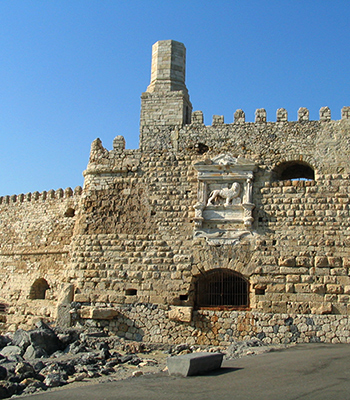 At the entrance of the port of Heraklion, where the western pier ends, an imposing Venetian fortress dominates, Koules. During the Venetian domination, it was known as Rocca a Mare or Castello a Mare that is a fortress at sea. It finally prevailed to be called "Koules", a name derived from the Turkish name Su Kulesi (fortress of water).
At the entrance of the port of Heraklion, where the western pier ends, an imposing Venetian fortress dominates, Koules. During the Venetian domination, it was known as Rocca a Mare or Castello a Mare that is a fortress at sea. It finally prevailed to be called "Koules", a name derived from the Turkish name Su Kulesi (fortress of water).
The first historical reference was made in the second Byzantine period (10th-13th) in 1303 where the existence of a tower called "Castellum Comunis" which was destroyed by a major earthquake, was mentioned. The Venetians, at the beginning of the 16th century when they occupied the island, built the fortress in order to have the greatest security of the harbor and within the framework of the general redesign of the fortifications of the city. The old building was demolished and at its position, the new fortress was built. Its construction lasted 17 years from 1523 to 1540 and huge sums of money covered by the fund of the Kingdom of Crete, the central treasury of Venice and the contribution of individuals, were demanded.
In the fortress of Koules, there were three entrances - west, north and southwest – and its main gate is located to the west having access to the land. Outside, on the main sides of the fortress, marble reliefs depicting the winged lion of St. Mark, a symbol of Venice, dominates. The fortress is built on a natural rocky outcrop, which the Venetians were forced to strengthen by sinking old galleys with rocks, gravels and boulders. It occupies an area of 3.600 square meters, it is two-story and the thickness of its outer walls reaches 8.70m.
Koules’ ground floor has a vaulted roof and contains 26 different rooms used for various purposes (food storage areas, munitions depots, water reservoirs and prisons). These rooms were lightened and ventilated by special openings on their ceilings, sospirali lucernai or aniforades (in Greek), which ended up in the roof of the fortress. There were two intersections leading from the main corridor: a sloping level on which the Venetians dragged the cannons and other supplies to bring them to the roof.
Upstairs, there were apartments for Castellanu (the castello commander) and the officers of the guard. Inside the fort, there was an oven, a mill, a small church and a reservoir of water that made the fort autonomous in a state of siege. In his report in 1630, the Venetian engineer, Francesco Basilicata, said that on the ground floor there were 18 cannons and on the first floor 25, while at the same time he counted 300 boxes of gunpowder and 6,144 balls of cannons, many of which are still preserved in the warehouses of the ground floor.
During the period of Egyptian domination in Crete (1830 - 1840), a lighthouse was constructed on the northeast corner of Koules. The lighthouse was destroyed in World War II but was reconstructed and continued to operate until 1960. It is worth noting that during the Ottoman domination in 1669, the Turks built a smaller fort at the edge of the eastern pier just opposite Koules on the side of the land, enhancing, in this way, the protection of the port. This was the so-called Little Koules, which however was demolished in 1936 along with parts of the Venetian shipyards for the development of the city.
A room on the ground floor of Koules, which is specially designed, is impressive. In this room, the cannons of "La Therese" (the vessel sent by Louis XIV to assist in the defense of the Venetians in the siege of Chandax but it was sunk after a burst in its powder store) and amphoras from the marine surveys in the Gulf of Heraklion are exhibited.
Nowadays, Koules is also used for art exhibitions, theatrical performances and various cultural events and is a favorite place for the citizens of the city who want to walk along the jetty having a nice view of the city of Heraklion and its harbor.
Administrative Information: Ephorate of Antiquities of Heraklion
Telephone: 2810243559 (Koules), 2810288484(Ephorate of Antiquities of Heraklion)
Email: efahra@culture.gr
Should you need additional information please visit the page for Koules or the relevant page at the site of the Ministry of Culture.